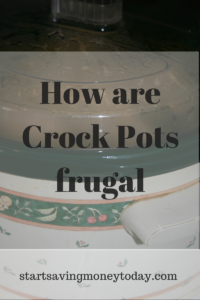How are Crock pots frugal
I remember when my mom got her first Crock Pot. I think she was the happiest woman on the planet. For weeks all she could talk about was how great it was. There were so many things she could make with it: soups, roasts, sauces, desserts… And, it would free up time. What a modern marvel!
Fast forward a little
About fifteen years later I got married, and guess what gift my bride was really enthusiastic about—a Crock Pot. I asked her why. I mean, I was sure the Army hadn’t used Crock Pots, and we’d eaten well enough. And, I could cook a hot dog in no time at all. Or a steak, I was great when it came to steaks. Well, it was like talking to my mother again. My wife gave me a list of all the things she could do with a crock pot. I was (almost) sorry I’d asked.
Fast forward some more
To this day, there is still a crock pot sitting on the kitchen counter, and it gets used a lot!!! I’ve learned to cook tender meat, make stew, bake bread, and all kinds of other good things to eat. Yes I use a crock pot.
What is a crock Pot?
You might be asking yourself what exactly is a “Crock Pot”?
It’s a slow cooker.
Crock-Pot® is one of several slow cooker brands. Crock-Pot® is a registered trademark owned by the Sunbeam Corporation. Sunbeam makes electric home appliances. Sunbeam’s Crock-Pot® was not the first slow cooker. (They’ve been around since the 1930s. The first patent for one was issued 1940.) Even Sunbeam’s ownership of the trademark name is a result of corporate mergers. Thanks to advertising in the 1970s “crock pot” has become a generic term for a slow cooker.
The way it works
A slow cooker is a countertop appliance used to prepare food that is traditionally boiled or baked—cooked on the stove top, or in an oven. It uses moist heat and low temperatures to cook. Cooking temperatures vary by brand, but in general a low setting will be under 200 degrees and the high setting around 250 degrees. These settings mean food can be allowed to cook for an extended period of time. (Many recipes call for 8 hours on low and 4 on high with the person preparing the food often given the choice of which setting to use.) Also, this cooking method does not usually require periodic stirring. This means the cook is not constantly required to be nearby throughout the cooking process.
The low cooking temperatures have a couple of advantages. What happens when you have your oven on in the summertime? It can get pretty hot in the house. So, you turn on the air conditioning, which means you are now increasing how much you’re spending on electricity and, maybe, gas. Because they cook at such low temperatures, you won’t have that problem when you cook with a slow cooker. (By the way, slow cookers use considerably less electricity than your oven or stovetop.) Another advantage is that a slow cooker can be “forgotten” for an extended period of time, and it isn’t likely to burn the food or catch on fire. You can’t say that about your stovetop or oven.
Current models usually come in three parts: the glass lid, the removable ceramic crock, and the heating unit. The crock fits into the heating unit, and the glass lid sits over the crock. Some models have clips or other means for securing the lid. Every instruction I’ve read says the lid is not to be fastened in place while cooking. That feature is a guard against spilling while transporting your slow cooker.
Why is a crock pot frugal?
When people say “frugal,” they’re usually thinking about something financial. (I’ve already mentioned that you can save money by using a slow cooker.) The financial take is good, but the whole answer is much bigger. A frugal lifestyle can and does include time management.
Historically, a person preparing a meal was pretty much tied to the kitchen. The cook (usually a woman) needed to monitor the item(s) being cooked; stir, check the heat, and add ingredients. Most slow cooker recipes have all the ingredients in the pot from the beginning of the cooking process (or added near the end). And, as I said above, stirring isn’t usually encouraged; lifting the lid quickly (and drastically) lowers the heat temperature and can mess with cooking times. That frees up the cook to do other things—including leave the kitchen, or the house, and return to a meal that is (almost) done.
In the 1970s there was a major of women’s movement. Many entered the workforce, but they still preformed most of the housekeeping functions, including cooking. Of course, there was prep work to be done before leaving, but the advantage of coming home to a meal that was at least partially cooked contributed greatly to the popularity of slow cookers. Today many families have realigned the division of household labor, but people are busier than ever. The popularity of the slow cooker is holding.
Conclusion
Call it what you will, crock pot or slow cooker. In either case, you can cook a lot of nutritious and delicious foods, and save time and money while you’re doing it.
Never miss another post follow me on Facebook

